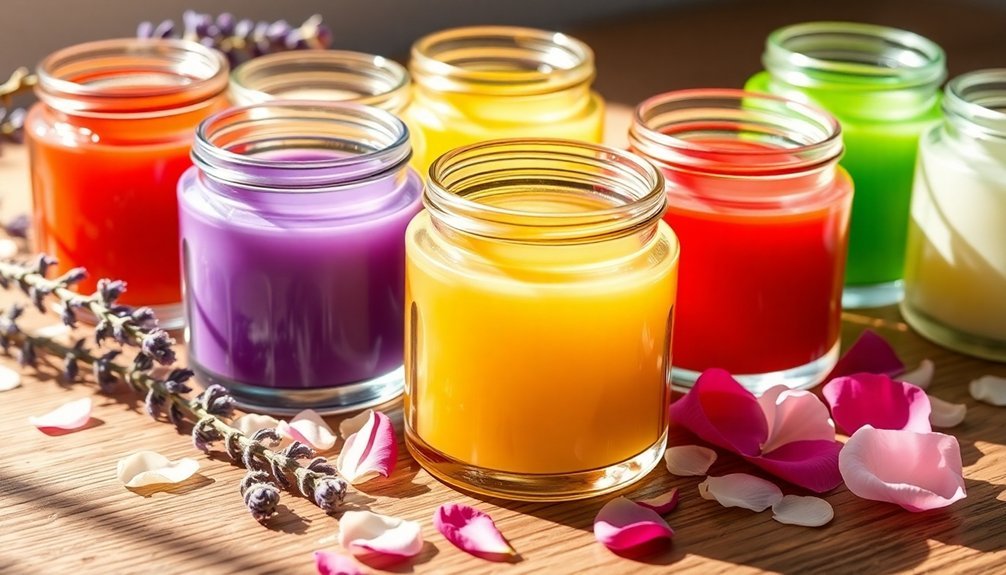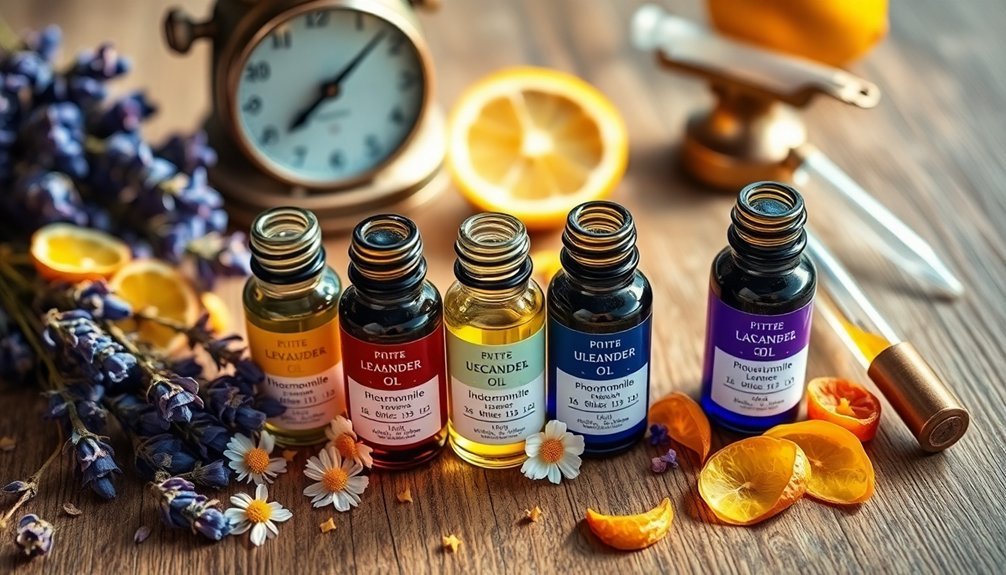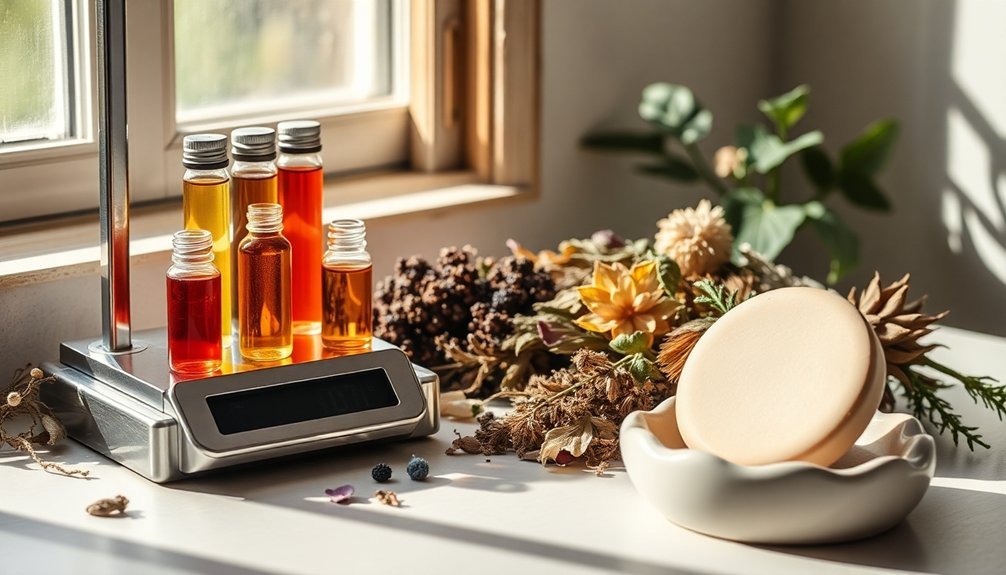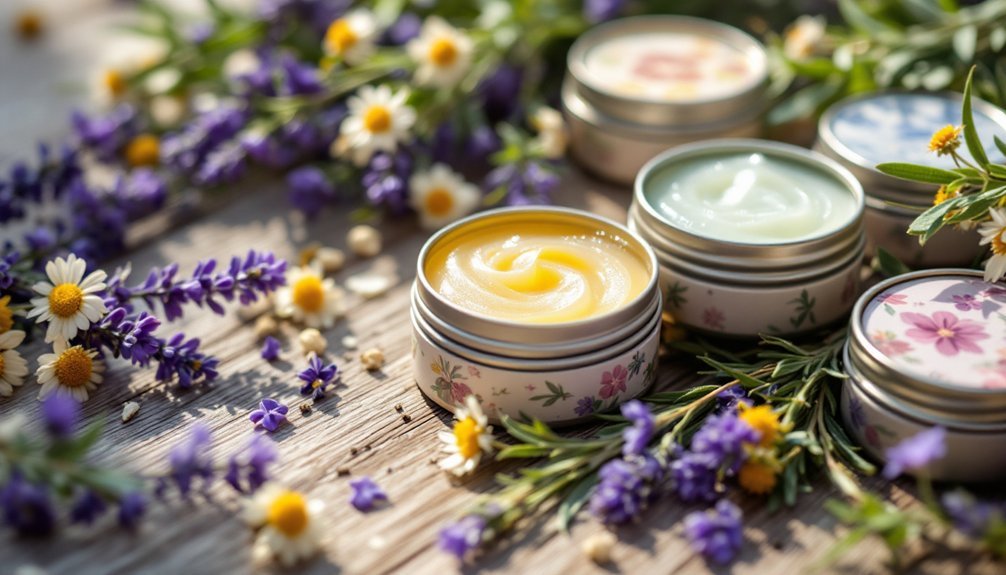Pro techniques for organic solid perfumes start with selecting essential oil combinations across top, middle, and base notes for depth. You'll need to master double-boiler wax melting at precise temperatures and blend carrier oils like jojoba or sweet almond for the perfect consistency. Focus on natural preservation methods, create layered fragrance profiles, and use eco-friendly packaging. These fundamentals will set you up for crafting stunning artisanal perfumes that rival commercial products.
Selecting and Blending Essential Oil Combinations

When it comes to creating organic solid perfumes, selecting the right essential oil combinations forms the foundation of your signature scent.
Start by choosing oils from different note categories to create a well-balanced blend. You'll want to include top notes like bergamot or lemon for initial impact, middle notes such as lavender or geranium for the heart of your fragrance, and base notes like cedarwood or sandalwood for lasting power.
Remember to dilute your essential oils with carrier oils like jojoba or almond to prevent skin irritation. Always test your blend by pouring into small tins and allowing them to cool completely before applying to skin.
Consider combining complementary scents, such as floral with citrus or woody with sweet. For a calming blend, try bergamot with vanilla and patchouli. If you're seeking an energizing scent, mix grapefruit, ginger, and lemongrass together.
Mastering the Double-Boiler Wax Melting Method
You'll master safe wax melting by setting up your double boiler with a heat-proof bowl resting securely above (not touching) the simmering water in your pot.
A double boiler insert is essential for creating homemade cosmetics like solid perfumes, ensuring even heat distribution and preventing ingredient damage.
Keep your heat at medium and monitor the temperature closely as your wax begins to melt, ensuring it doesn't overheat and damage the essential oils you'll add later.
Once the wax becomes fully transparent, you're ready to remove it from heat and proceed with your pour, maintaining a steady hand to achieve even distribution in your containers.
Safe Heat Control Basics
Mastering safe heat control through the double-boiler method stands as an essential foundation for creating organic solid perfumes.
You'll need to maintain ideal temperatures and guarantee even heat distribution to prevent your wax from burning. By avoiding direct heat contact, you're greatly reducing the risk of overheating while preserving the wax's quality.
Keep a close eye on your water levels in the double boiler, as this helps maintain consistent heat throughout the melting process. A gentle simmer with 1-2 inches of water provides optimal melting conditions.
You'll want to use a thermometer to monitor temperatures precisely, especially when working with different wax types like beeswax, which has a higher melting point.
Remember to stir periodically and remove the wax from heat once it's fully melted.
This careful approach guarantees your organic solid perfumes maintain their integrity and scent properties.
Equipment Setup Guide
Now that you understand heat control principles, let's focus on setting up your double-boiler system correctly.
You'll need a heat-resistant bowl or Pyrex measuring cup that fits securely over your pot of water. Make sure the bowl doesn't touch the water's surface directly.
Choose your heat source based on what's available – stovetop, microwave, or even candle warmth will work. Select a ceramic or glass container that's stable and won't tip over during the heating process.
Keep the water level below boiling point for even heat distribution throughout your wax mixture.
Remember to position your setup on a flat, stable surface away from any flammable materials.
You'll want enough space to work safely while maintaining easy access to monitor your melting progress and stir the mixture when needed.
Perfect Pour Timing
When working with the double-boiler method, achieving the perfect pour requires precise timing and careful attention to your wax mixture's consistency. You'll need to maintain medium heat while monitoring the temperature to prevent overheating your wax and carrier oils.
| Stage | Temperature | Action |
|---|---|---|
| Initial Melt | Medium Heat | Add wax to double boiler |
| Oil Addition | Wax Fully Melted | Mix in carrier oils (1.5:0.5 ratio) |
| Final Pour | Off Heat | Add essential oils, then pour |
Once your wax has completely melted, blend in your chosen carrier oil (jojoba, sweet almond, or grapeseed). Remove the mixture from heat before adding essential oils to preserve their aromatic properties. You'll know it's time to pour when the mixture is fully liquid but not too hot. For the best results, pour immediately after adding your essential oils.
Achieving the Perfect Carrier Oil Ratio
The perfect carrier oil ratio forms the foundation of any successful solid perfume.
You'll want to start with equal parts beeswax and carrier oil as your base, then adjust according to your desired consistency.
When selecting your carrier oils, consider blending multiple types for ideal results.
Here's what you'll need for a balanced blend:
- Jojoba oil for stability and non-greasy texture
- Sweet almond oil to enhance smoothness
- Fractionated coconut oil for longevity
- Grapeseed oil for lightweight feel
- Rosehip oil for added skin benefits
Remember that you can customize these ratios to suit your preferences.
A combination of two to three carrier oils typically works best, with jojoba oil as your primary base.
Keep in mind that different oils affect both the fragrance retention and the final texture of your solid perfume.
Natural Preservation Methods for Extended Shelf Life

You'll find that cold storage is one of your most effective tools for preserving organic solid perfumes, as lower temperatures greatly slow down ingredient degradation and help maintain scent integrity.
When storing your essential oils, keep them in dark amber bottles and always seal them tightly to prevent oxidation and maintain their stability.
To maximize the preservation benefits, you can combine cold storage with natural antioxidants like vitamin E, which creates a powerful defense against premature aging of your perfume formulations.
Cold Storage Benefits
Proper storage techniques greatly extend the life and potency of organic solid perfumes, making cold storage one of the most essential preservation methods.
You'll need to maintain temperatures between 60°F to 70°F to prevent melting and preserve your perfume's integrity.
For ideal cold storage results, follow these key practices:
- Store your perfumes in a cool, dark drawer or cabinet away from direct sunlight
- Keep containers tightly sealed to prevent moisture from affecting the texture
- Avoid bathroom storage where humidity and temperature fluctuate frequently
- Choose opaque, airtight containers to protect against light exposure
- Skip storing in your car where extreme temperatures can damage the formula
Essential Oil Stability Tips
While essential oils form the heart of organic solid perfumes, maintaining their stability requires careful attention to storage and handling practices.
You'll need to store your oils in dark, airtight containers away from heat and light to prevent oxidation. When working with essential oils, always use clean droppers or pipettes, and avoid touching the bottle openings with your fingers.
Consider incorporating natural preservation methods like encapsulation or nanoemulsions to extend shelf life. You can also leverage the antimicrobial properties of certain oils in your blends for added stability.
Monitor your oils regularly for changes in aroma or consistency, as these can indicate degradation. Remember that citrus oils have shorter shelf lives than other varieties, so you'll want to use these more quickly or take extra preservation steps.
Creating Layered Fragrance Profiles
Creating sophisticated layered fragrance profiles requires understanding the delicate interplay between different scent notes and their application methods.
You'll want to start with your strongest base notes, allowing them to dry completely before adding middle and top notes. This systematic approach guarantees each layer maintains its distinct character while contributing to the overall fragrance harmony.
For best results, follow these essential layering steps:
- Apply fragrances to clean, prepped skin
- Start with your most concentrated base oils
- Let each layer dry completely before adding the next
- Use middle notes to create smooth shifts
- Document successful combinations for future reference
Remember to experiment with different application techniques and consider using fragrance primers to enhance the blending effect.
Testing combinations in a controlled setting will help you perfect your signature scent profile.
Temperature Control Techniques for Optimal Results

Beyond mastering fragrance layering, successful solid perfume creation hinges on precise temperature control throughout the manufacturing and storage process.
You'll need to carefully monitor heat levels, as your solid perfumes can melt below 54°C and undergo unwanted consistency changes.
When mixing ingredients, use heat-resistant materials and combine them with temperature-stable compounds like Shea Butter and Beeswax.
You'll want to dissolve ingredients slowly and cool them gradually to maintain uniform consistency.
To protect your finished product, store it in a cool, dry place away from direct sunlight and heat sources like radiators.
It's best to keep your perfumes in a climate-controlled environment to prevent the texture from becoming brittle or mushy and to preserve the fragrance's longevity.
Packaging Solutions for Solid Perfumes
When choosing packaging for your solid perfumes, you'll find eco-friendly options like kraft paper tubes and biodegradable containers that align with sustainable beauty practices.
You can enhance your brand's environmental commitment by selecting containers made from recycled materials while maintaining the luxury appeal through premium finishes and custom printing.
Travel-sized cases with secure closures offer both portability and protection, making your solid perfumes perfect for on-the-go use while eliminating concerns about liquid restrictions.
Eco-Friendly Container Options
The sustainable packaging revolution has transformed how solid perfumes reach consumers, with eco-friendly containers leading the charge.
You'll find innovative options that protect both your product and the planet, from biodegradable materials to recyclable metals.
Choose from these earth-conscious container options:
- Kraft tubes made from sustainable materials, perfect for solid perfume bars
- Recyclable aluminum or tin boxes that minimize plastic waste
- Biodegradable containers crafted from wheat straw
- Customizable cardboard packaging that's fully compostable
- Refillable twist-up containers made from eco-friendly alternatives
These packaging solutions don't just reduce your environmental impact – they're also cost-effective and appealing to conscious consumers.
With compact designs and minimalist aesthetics, you'll create less waste while maintaining product quality and brand integrity.
Portable Travel Cases
Modern travelers seeking convenient fragrance solutions will appreciate portable solid perfume cases that combine practicality with elegance.
You'll find these cases crafted from durable materials like sterling silver, designed to fit comfortably in your palm while meeting TSA requirements.
These versatile containers offer smart features you'll love: they're refillable, spill-proof, and perfect for creating custom scent combinations.
You can apply your fragrance by simply rubbing the solid onto your pulse points, making it ideal for touch-ups throughout the day.
Many cases feature beautiful engravings or custom designs, often presented in decorative silk pouches.
Essential Oil Dilution Safety Guidelines

Safe handling of essential oils requires strict adherence to dilution guidelines, as these concentrated plant extracts can cause severe skin reactions when used improperly.
For your solid perfume creations, you'll need to follow proper dilution ratios to guarantee safety and effectiveness.
- Always start with a 2% dilution for adults (10-12 drops per fluid ounce), or 1% for children and elderly.
- Choose appropriate carrier oils like jojoba, avocado, or coconut oil for even distribution.
- Perform a patch test before using any new essential oil to check for sensitivities.
- Never exceed recommended dermal maximums, even in solid perfume formulations.
- Store your oils properly to maintain their potency and safety profile.
Color Integration Using Natural Ingredients
While creating stunning organic solid perfumes, you can enhance their visual appeal by incorporating natural colorants that add both beauty and therapeutic properties.
You'll find beetroot powder excellent for achieving deep reds, while turmeric delivers vibrant yellows. For greens, try spirulina or chlorophyll powders, and consider indigo for blue hues.
When working with natural colorants, you'll need to account for stability factors. Keep your perfumes protected from UV light to prevent fading, and be mindful of moisture sensitivity.
Adding small amounts of mica can create a lovely shimmer effect for special occasions. You can also experiment with herb infusions and absolutes, which provide subtle color while contributing to your perfume's fragrance profile.
Testing and Adjusting Fragrance Intensity

Creating the perfect fragrance intensity in solid perfumes requires a systematic approach to testing and adjustment.
You'll need to carefully balance essential oils with your carrier oils and waxes while considering how different natural waxes affect scent release.
- Start with olfactory testing to evaluate your initial fragrance intensity and make notes.
- Adjust the ratio of essential oils gradually, testing each variation for ideal strength.
- Add natural fixatives to stabilize volatile organic scents and extend longevity.
- Consider your wax selection carefully – different types will affect how the fragrance develops.
- Test your perfume's performance in various environmental conditions.
Remember that natural fragrances may need more frequent application than synthetic ones, so you'll want to find the sweet spot between intensity and longevity through systematic testing and refinement of your formula.
Frequently Asked Questions
Can I Use Candle Wax Instead of Beeswax for Solid Perfumes?
You shouldn't use candle wax for solid perfumes as it's not suitable for skin application and has an incorrect melting point. Instead, opt for beeswax, candelilla wax, or soy wax alternatives.
How Do I Remove Solid Perfume Stains From Fabric and Clothing?
First, blot the stain with paper towels, then apply liquid dish soap directly. If it's stubborn, use a mixture of vinegar and water. Don't use hot water, as it'll set the stain.
Will Solid Perfumes Melt in My Pocket or Purse?
Yes, solid perfumes can melt in your pocket or purse due to body heat. You'll want to store them in a cool place and avoid keeping them in pockets for long periods of time.
Can I Reuse Containers From Old Solid Perfumes for New Batches?
You can reuse glass or ceramic containers from old solid perfumes after thorough cleaning. However, avoid plastic containers as they'll retain old scents. Be sure to sanitize completely before adding new batches.
Do Solid Perfumes Last Longer on Pulse Points Than Liquid Perfumes?
Yes, you'll find solid perfumes last longer on pulse points than liquid ones. Their wax base releases fragrance more gradually, and they're less volatile when exposed to your body heat and environmental conditions.





Leave a Reply